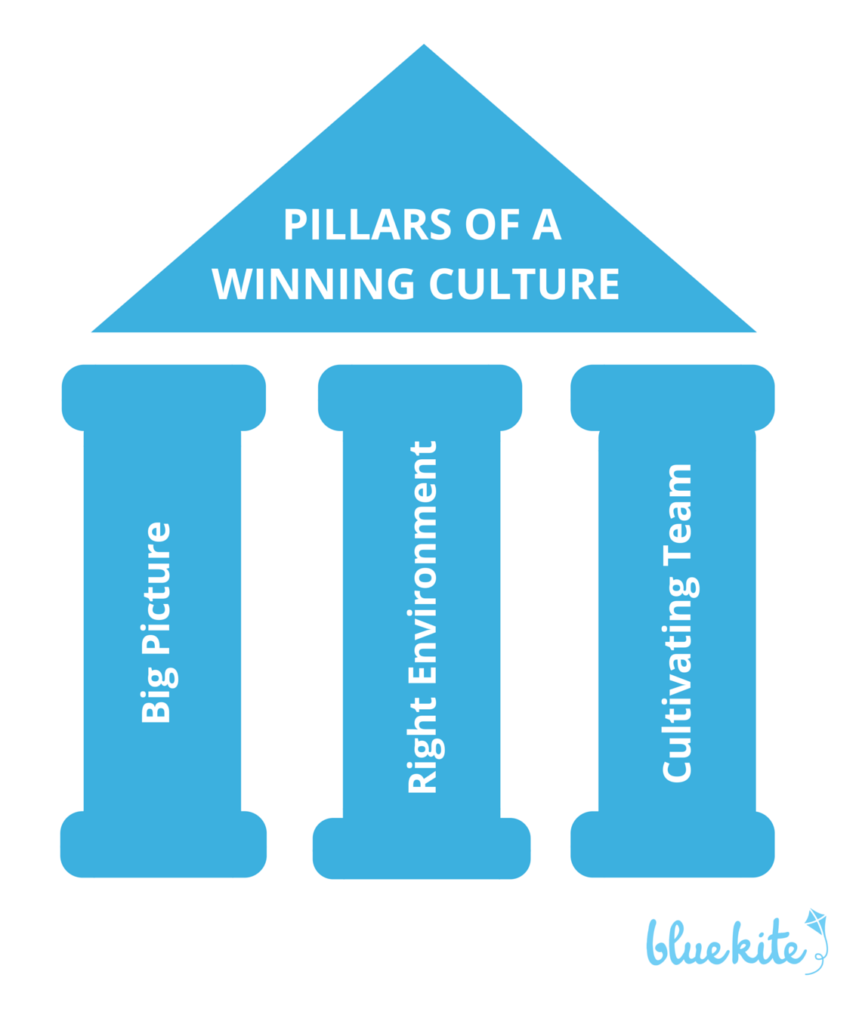When it comes to company culture, the tendency is to think about ways to benefit the team as a whole. However, thinking about employees on an individual level is the key to keeping them engaged, productive and loyal to your company.
Not to mention, happy employees can be your biggest advocates. If they love where they work, employees are more likely to tell others about your brand and promote your company online – essentially turning your entire team into an incredible marketing asset.
We believe that cultivating your team members is an important ingredient for strong company culture. In fact, it’s our third and final pillar in our series on creating a winning culture.
As a reminder, here are the three pillars to creating a winning culture:
- Getting the big picture right
- Creating the right environment
- Cultivating your team
You need all three of these components to create a remarkable company culture that stands apart from competitors, attracts and retains top talent and ultimately achieves greater success.
CULTURE PILLAR 3: Cultivating Your Team
So, how do you cultivate your team in a way that helps you build a strong culture?
Focus on the following three areas with your individual employees to create a loyal and engaged team:
1. Individual growth opportunities
Far too many companies care more about what employees can do for them instead of considering what you can do to invest in employees.
But, investing in employee training and personal growth is one way to show you care about employees, while also building a stronger company. After all, advancing the skills and knowledge of your team gives you the ability to keep employees longer and groom them for leadership roles.
And, when you invest in the growth of your team, those employees stick around.
So, how do you establish growth opportunities as a part of your company culture? Here are a few ideas:
- Understand career goals. Taking the time to discover an employee’s career goals and helping them work toward them is a great way to invest in their success. That’s something we do at Blue Kite. It starts with our hiring process. We talk about where candidates want to go with their careers so we can determine if we are a good fit to help them get there. Once someone is hired, we work with that person to create opportunities to help the team member develop the desired skills to build the career they want – even if that means leaving Blue Kite. Supporting the career goals of our team members has proven a valuable way to have invested and engaged team.
- Offer education. Starbucks is a bold example of investing in employee education. The company offers free tuition through Arizona State University for all employees. Starbucks sees this as a great way to invest in their employees (and recruit new ones). But, you don’t have to go that far to provide educational opportunities. Paying for conferences or online training is a great way to grow the skills of your team.
- Invest in dreams. I’ve long been a fan of the culture at LetterLogic, a Nashville-based lettershop. One way they invest in their people is by giving employees who have an interest in entrepreneurship are given the opportunity to move from job to job within the company to learn the business. Then, LetterLogic helps pay to fund the employee’s startup.
Whether you create internal training programs, invest in personal passion projects or encourage innovation within your company, you will find that fostering employee growth opportunities will go a long way toward the happiness of your team.
2. Employee Wellness
There are lots of good reasons good people quit. But, burnout ranks high on the list.
According to a study by TinyPulse, employees who are overly tired and burned out are 31% more likely to think about looking for a new job than employees with a manageable workload.
On the flip side, that same study showed that employees who have a
positive work-life balance are 12% more likely to stay at their company. And employees who are encouraged to take all of their vacation time are 13% more likely to stick around.
The bottom line?
Paying attention to the wellbeing of your employees isn’t just a nice thing to do. It turns out it can have a huge impact on the retention of your team and the overall culture of your company.
So, how do you do that?
Here are a few ideas:
- Focus on physical health. MotleyFool values collaboration. One way they foster that? Free in-house bootcamps and spinning classes. They also offer personal training and wellness sessions and 50% reimbursement for enrolling in races, such as a 5K. They even have a wellness newsletter for employees.
- Offer unlimited vacation. Mammoth, an HR technology company, offered a flexible vacation schedule for a year. Although employees took roughly the same amount of PTO as they did under the previous plan, it was viewed as one of the company’s most valued benefits because it treats employees individually and holistically.
- Create a healthy schedule. Many companies offer flexible schedules. And that is a great way to allow employees to work in a way that fits their personal rhythms. One way to take this idea even further is to create a seasonal schedule. Jason Fried at 37Signals (now Basecamp) gives employees a four-day work week from May through October. They don’t cram 40 hours into four days, but instead work four regular work days. Working less forces employees to be more focused and get more done in less time. But, this approach also creates a healthy rhythm and schedule for their team.
Paying attention to workload and stress and encouraging time off can be great ways to encourage healthy behavior – and that doesn’t cost a dime.
3. Recognition and Rewards
What’s the number one factor in employee happiness?
It’s not money. Or perks.
According to a study by Boston Consulting Group, employees value appreciation for their work more than anything else.
Certainly, salary matters. But it’s not a great motivator – at least in the long term.
Instead, people want to know their ideas, work and contribution is valued. Essentially, employees want to know that their work matters and that they are contributing to something bigger than themselves.
That’s why recognition can be extremely powerful – especially when it comes from a leader of the company.
An easy way to do this is to simply acknowledge an employee’s job well done – both privately and publicly. But, recognition can also be a great way to reflect your company culture.
If you want to see a great example of how this is done, check out CJ Advertising. As part of their “camel culture”, they place a huge emphasis on employee recognition.
When you visit their office, there is a wall recognizing employees who have been at the company for more than five years. CJ Advertising also gives anniversary gifts for key milestones – company jackets at five years, a rolex at 10 years and a vacation at 15 years.
In addition to rewarding longevity, CJ also recognizes employees at weekly staff meetings, through their employee of the month program and peer recognition program. They also have a team of employees who deliver surprises to team members who have been working extra hard and need a pick-me-up.
There are tons of ways to reward employees for a job well done. The bottom line is that you should do it. Not only will recognition improve morale and help your team stick around, but also increase overall performance as a company as well.
Creating a Winning Culture – More Important Than Ever
Every company has a culture. The question is whether yours is created by default or by design.
The answer is the difference between mediocre companies and those that have massive success. If you want to be the latter, it pays to focus on the culture you are creating.
Remember, foosball tables aren’t enough. To create a winning culture, you must cast a compelling vision, establish the right environment and invest in your team.
When you do that, your business will be a champion that will be tough to beat.




